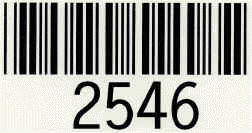
| Bar Code Labeling |

| Bar Codes are precise arrangements of parallel lines (bars) and spaces that vary in width to represent data. Bar Codes are composed of the following elements: |
|
| Bar Codes are either variable data demand printed using inkjet, thermal, or thermal transfer technology or they are composed as a design element and printed as repetitive data on product packaging. Variable data bar codes are typically demand printed with direct thermal or thermal transfer printing. |
| Direct thermal printing uses a semiconductor with hundreds of
individual heating elements which come in direct contact with the surface of
a temperature sensitive chemical coated label surface. Turning elements on
and off in controlled patterns renders a visible image on label. Labels
produced with direct thermal are not permanent and turn black or dark
brown with exposure to either ultra violet light or heat after a short
time. Thermal transfer printing uses the same semiconductor print head but places a wax or wax resin coated ribbon between semiconductor and surface of label. Images printed with thermal transfer process can be permanent when appropriate label and ribbon components are optimized. |